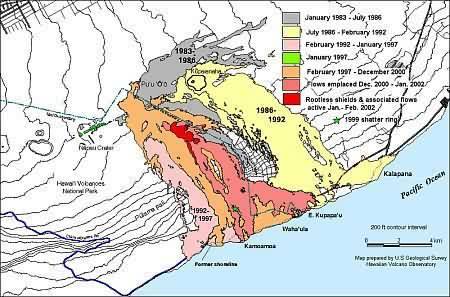Pu`u `O`o -- much has happened in the past day or so
4/7/02 5:30:45 AM Pacific Daylight Time
Just read your concern about lava slipping. Good reason
to be worried, I'd say.
UPDATE 1320 April 6
A brief trip to Pu`u `O`o this morning shows that much has happened in the
past day or so. The crater lake has risen about 8 m since March 29 and now
stands 17 m below the east rim. The cones of the East Pond Vent and the January
Vent are the two most active ones. Stubby flows have built a mound around
each cone; the two mounds have coalesced to form a high area looking down
on a crescentic lava lake nearly encircling the high area. Lava from the
two vents flows a short distance down the mound and then plunges into the
lake. Crust on the lake is frequently overturning.
Outside Pu`u `O`o, active lakes occupy the Episode 55 pit, Puka Nui, and
Lua Hou. Sometime in the past day, lava flowed over the east rim of Puka
Nui and advanced a kilometer or so as dark `a`a. When observed at 0930 this
morning, lava was slowly leaving Puka Nui as shiny pahoehoe.
The tilt oscillations continue at irregular intervals at Pu`u `O`o. See tilt
plots below, as well as eight photos taken this morning between 0920 and
1000.
UPDATE 0818 April 6
Pu`u `O`o is at it again, now in its fourth deflation-inflation oscillation
since about 0508 this morning, the fourth starting only minutes ago. Volcanic
tremor has picked up at Pu`u` O`o in the past two hours, to the point where
it is now the strongest in some time. Tour pilot's are reporting 8-10-m-high
spattering in Pu`u `O`o's crater. Kilauea's summit is oblivious to the
oscillations at Pu`u `O.
0555 April 6
Kilauea had quite a ride yesterday. The tilt plot below shows it graphically,
and the events are summarized later in this update.
This morning at 0444, bright glow comes from the crater of Pu`u `O`o and
from two areas along the chain of rootless shields. Four small breakouts
are moving on the lower one-third of Pulama pali and the upper part of the
lava fan. Intrepid hikers ascend the fan and lower pali to see the
breakouts.
Yesterday's events had their beginning at about 2100 on April 4, when Kilauea's
summit began to deflate. Pu`u `O`o followed suit about 30 minutes later.
The deflation at the summit had nearly bottomed out by 1600 on April 5, having
lost about 1.7 microradians. Pu`u `O`o was continuing to drop, however, having
lost almost 9 microradians.
Abruptly at 1600 on April 5, the summit began to inflate very rapidly. The
inflation was slightly preceded by rather strong volcanic tremor beneath
the caldera. When the inflation ended at about 1700, the summit had popped
up a little over 6 microradians and the tremor had died back to its normal
level. Thereafter, the summit began to deflate, as it is currently doing,
losing about 4.3 microradians at the time of this writing.
Pu`u `O`o was not to be outdone. It began to rapidly inflate about 12-13
minutes after the summit. The cone continued to inflate until 1800, by which
time about 7 microradians had been regained.
Then a remarkable thing happened. The cone started oscillating, with rapid
deflations amounting to 1 to almost 3 microradians starting at 1800, 1920,
and 2100, with intervening slower inflations separating the deflations. The
first inflation didn't make up the preceding deflation, but the second was
somewhat larger than the preceding deflation. Following the third deflation,
slow inflation started, eventually bottoming out early this morning.
Weather conditions at Pu`u `O`o were lousy yesterday. Attempts to see changes
in the late morning were essentially futile, though enough was observed to
know that not much was happening at that time. Four of the rootless shields
were active when seen yesterday morning, as well as a hornito or two. No
observations of the crater have been made following the series of tilt
oscillations.
All during this time, tremor at Pu`u `O`o has blithely continued on, seemingly
unaffected by the tilt event. The summit seismicity, however, showed a pickup
of long-period earthquakes over the past several days, peaking just before
yesterday's inflation. After the inflation ended, the small earthquakes dropped
back to a normal level. Elsewhere on the volcano, tilt and seismicity are
behaving normally.
Lava Flows at Pu`u
O`o
Large version


